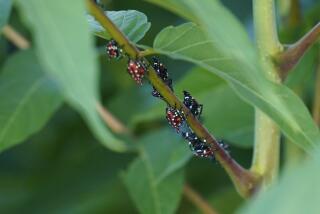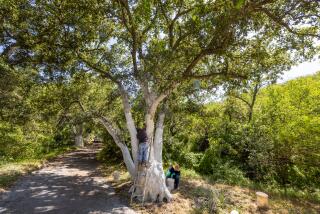Flightless Beetle That Eats Alfalfa Roots Poses Problem of Containment
- Share via
WOLCOTT, N.Y. — For 28 years, Greg Cooke has tracked a certain pug-faced bug around Lake Ontario so that farmers across the country won’t have to deal with it.
He’s got plenty of bug detective stories and a bad back, which hasn’t been helped by his frequent forays in search of the dime-sized alfalfa snout beetle.
“I’ve dug up more alfalfa plants than I care to remember,” said Cooke, a botanist with New York’s state Department of Agriculture and Markets.
Why all the concern over a beetle that came from Europe more than 100 years ago?
For one thing, the bug is found nowhere in this country except on the eastern shore of Lake Ontario, and Cooke and his fellow agriculture officials want to keep it there.
“The rest of the country relies on us to protect them, and so far, we have,” said Cooke, who is stationed in Syracuse and also supervises the inspections of greenhouses and Christmas tree crops.
The snout beetle’s favorite meal and namesake is important to all farmers. Alfalfa is grown as feed for cattle and is planted as a natural fertilizer to restore nitrogen to the soil.
Alfalfa is used in making vitamins. It is fed to race horses and is an ingredient of some cosmetics. Alfalfa sprouts are a popular addition to salads.
About 90 million tons of the green hay is grown each year in the United States, most of it in Wisconsin and Minnesota, according to Wanda Cobb of the American Alfalfa Processors Assn. in Overland Park, Kan.
“The beetle wipes out a stand of alfalfa in a very short time, and because it’s so devastating, we do take it seriously,” said Ed Bechinski, assistant professor of entomology at Cornell University.
Cooke calls the beetles “underground lawn mowers.”
Besides alfalfa, the bug has been known to eat the roots of grape, strawberry, raspberry, dandelion, daffodil and a number of other plants.
Should the alfalfa snout beetle ever go beyond its limited habitat in Upstate New York, farmers could have an “insidious and persistent” problem on their hands, Cooke said.
How likely is that, given that the insect cannot fly and is extremely clumsy and slow-moving?
“I have no idea,” Cooke said. “The problem is that it’s main mode of transportation seems to be man.”
Cooke has seen the bug, which on its own travels perhaps 1,500 feet in a lifetime, in fields miles away from the nearest known infestation. Last year, the beetle popped up in a Canadian alfalfa field across the river from New York.
And, of course, it somehow made the unlikely journey across the Atlantic. No one is quite sure how that happened, Cooke said.
One colorful--but probably untrue--theory is that Hessian soldiers brought the bug with them in hay bedding when they came through the Port of Oswego during the War of 1812.
Cooke said that the beetle doesn’t fancy cut hay. It prefers the roots of alfalfa, and there is no evidence that it has been moved in hay shipments.
The more likely scenario is that ships carrying light or fragile cargoes from Europe, such as glassware or fabrics, transported the bug in soil that was used as ballast. The ships dropped off the beetle-infested soil because they made the return trip with a much heavier cargo of pine timbers and didn’t need ballast.
The beetle wasn’t identified until 1896, when it was found on an Oswego farm. It didn’t approach numbers that could cause damage until the 1930s, when Cornell scientists first began to study it.
The insect’s territory today includes an area of more than 350,000 acres either infested or at risk, Bechinski estimated.
The beetle has been found in six New York counties--Oswego, Jefferson, Cayuga, St. Lawrence, Wayne and Lewis--and in Canada in the Kingston area.
Cooke was surprised nearly 20 years ago to find the beetle in Wolcott, 20 miles from the nearest infested field.
To find out how it got there, Cooke had to learn about bees.
“Beekeepers take their bees to clover and alfalfa fields (in Jefferson and Oswego counties) to get a better honey,” he said. “So we think there’s a high probability that they moved the snout beetle when they took the bees to the apple orchards of Wayne County.”
The beetles, all females, live underground for a year. In spring, they migrate in swarms across roads and into other fields, looking for places to lay their eggs.
They both produce and fertilize the eggs, a form of reproduction known as parthenogenesis.
The infestation is dangerously close to the state Barge Canal system, another potential mode of transportation, since snout beetles by the hundreds can form a “bug ball” that can travel in water.
The beetle is contained now because the bowl-shaped region it inhabits carries all water in the area into Lake Ontario, Cooke said, but if it were to get into another water system it could move quite easily from there.
Cooke believes that the beetle found its way into Canada by following the currents of the St. Lawrence River.
“What they do is cling to each other and float along until they hit some land, and then they break apart and walk on shore,” he said.
Monitoring and containment is important, but Cornell’s Bechinski wants to find a way to eliminate the alfalfa snout beetle.
Last year, he began research into a plan to destroy the beetles by using microscopic worms that bore into the larvae and kill them. He’s also looking into ways to use insecticides more efficiently.
Cooke said it is difficult to kill snout beetles with the poison, because they are seldom found above ground.
“We’re not going to wipe it out, so we’re just hoping to limit where it goes,” he said.
More to Read
Sign up for Essential California
The most important California stories and recommendations in your inbox every morning.
You may occasionally receive promotional content from the Los Angeles Times.













